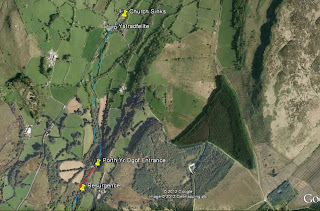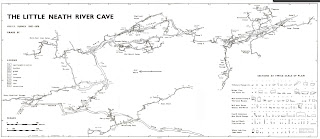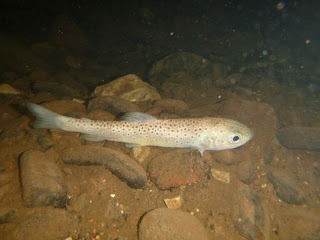 |
| Porth yr Ogof Main Entrance from inside |
Porth Yr Ogof cave is in the Brecon Beacons National Park,
The name Porth Yr Ogof translates best as ‘Gateway to the Cave’ in Welsh.
It boasts the largest cave entrance in
The river Mellte can be seen to enter the Main Entrance
(entrance ‘E’ on the survey) and can be followed right the way through the cave
in dry weather to re-emerge at the Resurgence (entrance ‘N’ on the survey).
The first recorded explorations of the cave were in the 18th
century by travellers. The cave was fully explored and surveyed by various
caving organisations from 1936 onwards.
In the 1950s there were studies conducted into the flora and
fauna of the cave.The Ystradfellte reservoir lies at the head of the valley and the river Mellte flows down through Ystradfellte village, where it sinks underground at Church Sinks. It re-appears some 900m (in a straight line) downstream at Porth yr Ogof cave. A dye connection made in 1964 recorded a time of 2.25 hours to re-appear at Tradesmans entrance (Entrance ‘C’ on the survey).

Cave diving began in Porth yr Ogof in 1961 and the Cave Diving Group have been occupied with explorations ever since.
Lloyd O.C, Standing
P.A, Newton University
of Bristol Speleological Society

Little Neath River Cave
Little Neath River Cave (known as LNRC) is in the Nedd
Fechan Valley South Wales , Uk Bridge
Cave
 The system has no less than 8 sumps (the detailed
description of LNRC in the UBSS proceedings is out of date and sump 8 has now
been discovered and dived) and passing sump 4 allows the diver to access very
grand and well decorated dry passage called the ‘
The system has no less than 8 sumps (the detailed
description of LNRC in the UBSS proceedings is out of date and sump 8 has now
been discovered and dived) and passing sump 4 allows the diver to access very
grand and well decorated dry passage called the ‘New World ’.
Project Baseline South Wales is primarily concerned with sump 1, between the adjacentBridge Cave
The cave is on the East bank of the Nedd Fechan river and is
on private land. Permission from Blaen Nedd Isaf farm and an access fee are
required prior to entering the cave.
The entire system is 8,800m long and the entrance floods to
the roof. It should only be accessed in the driest, most stable of weather.
 The system has no less than 8 sumps (the detailed
description of LNRC in the UBSS proceedings is out of date and sump 8 has now
been discovered and dived) and passing sump 4 allows the diver to access very
grand and well decorated dry passage called the ‘
The system has no less than 8 sumps (the detailed
description of LNRC in the UBSS proceedings is out of date and sump 8 has now
been discovered and dived) and passing sump 4 allows the diver to access very
grand and well decorated dry passage called the ‘Project Baseline South Wales is primarily concerned with sump 1, between the adjacent
Trout in LNRC sump 1 - seemingly blind and mostly white in colour.
Photo Christine Grosart

.jpg)
.jpg)